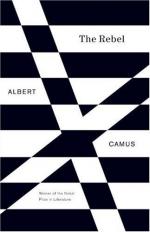|
This section contains 558 words (approx. 2 pages at 400 words per page) |

|
Part 4 Summary and Analysis
"Rebellion and Art"
The author begins this section with the comment that because art "rejects the world on account of what it lacks and in the name of what it sometimes is," it is rebellion in its purest form. He goes on to suggest that the visions of the future found in the work of the artist and in the (theories? actions?) of the rebel are essentially the same thing, with the basic difference that art takes the future out of the realm of history (event or goal), and places it into the realm of what already is.
"Rebellion and the Novel"
Here the author writes that the main reason novels (perhaps all art?) are both created and enjoyed is to create a sense of unity and order in a world where there is none. They do so, he suggests, by...
(read more from the Part 4 Summary)
|
This section contains 558 words (approx. 2 pages at 400 words per page) |

|




